Charging Li+ batteries in mobile phones and PDAs is a balancing act. On one hand, high current is needed to quickly replace the energy drained from the battery while transmitting voice or data. On the other, a charger needs to be small, to fit inside ever-shrinking mobile-phone and communicating-PDA form factors. Knowing the types of chargers that are available and the tradeoffs between them allows a designer to choose the right charger for a specific application.
Requirements of Li+ Battery Chargers
A Li+ battery charger must limit the charging current and the battery's maximum voltage. Designers should consult the battery manufacturer to determine what's required to safely charge a particular battery. Other features are often added to improve the life of the batteries or the operation of the charger. These include reduced charging current for over-discharged cells, detection of faulty cells, battery voltage monitoring and/or fuel gauging, input-current limiting, turning off the charger after charge completion, automatically restarting charging after partial discharge, charge state indication, and external charger enable/disable control.These features can be implemented in the charger itself, in an ASIC or a discrete circuit, or possibly within the software found within a microcontroller. Circuit designers decide which features to include and how to implement them based on the specific application and the level of cost or complexity that is tolerable.
Types of Li+ Chargers
Li+ battery chargers come in three types: switch-mode, linear, and pulse. The major difference between these topologies is the size and cost vs. performance tradeoff they offer.Switch-mode chargers tend to be larger and more complex and require a large passive output LC filter; the extra board space buys added efficiency.
Linear and pulse chargers take up little board space and require a minimum of external components. Although a linear charger may not require much board space to accommodate the IC and its external components, it may need additional board area to dissipate the heat generated by the charger's pass transistor. Pulse chargers don't present this problem. However, they do require a current-limited AC adapter, which is usually more costly.
Switch-Mode Chargers
Figure 1 shows the schematic of a typical switch-mode Li+ charger circuit. It uses the MAX1737 Li+ battery-charger controller with dual n-channel MOSFETs to step the AC adapter voltage down to the battery voltage. The power dissipation of this circuit remains below about 1W over the entire battery voltage range and over a wide range of AC adapter voltages. This circuit can be easily scaled up to allow as many as four series cells to be charged at currents of up to 4A.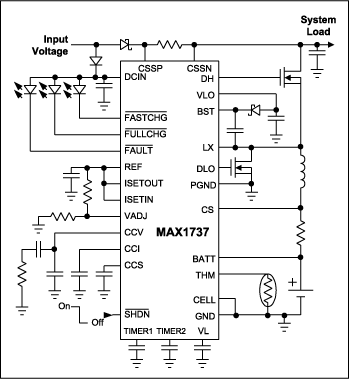
Figure 1. The MAX1737 Switch mode Li+ charger.
Switch-mode chargers have consistently low power dissipation over wide variations in input and battery voltage, a definite advantage over linear chargers. Switch-mode chargers also hold an advantage over pulse chargers: they perform well over a wide range of input voltage, allowing the use of a smaller and cheaper AC wall adapter than when using a pulse charger. The main disadvantages of this type of charger are its size and complexity. The controller, along with its external switches and LC filter, consumes more board space than other types of chargers. Other disadvantages include the EMI and electrical noise caused by the switching action of the charger and the radiation caused by the output filter inductor. The controller's fixed switching frequency, however, allows electrical noise to be easily filtered, but care must be used in circuit layout and component selection to prevent interference problems.
The charger circuit shown in Figure 1 includes many other features that improve both battery life and system operation. For example, the charger circuit's controller permits a limit to be placed on the current that flows into the circuit. When this current rises to the limit, the controller automatically reduces the current charging the battery, putting a cap on the current that can flow into the circuit's input. Because the charger limits the input current, a smaller, and generally cheaper, AC wall adapter can be used to power the circuit.
The charger includes a state machine that turns off the charger after charging is complete and automatically restarts charging when some of the charge has been drained from the battery. Safety features include the gentle precharging of over-discharged batteries at a reduced current and the ability to detect faulty batteries. In addition, charge and state indicators can directly drive LEDs or communicate with a microcontroller.
Linear Chargers
One way to minimize the size and complexity of the charger is to use a linear charger. The linear charger uses a pass transistor (typically a MOSFET, but sometimes a bipolar transistor) to drop the AC adapter voltage down to the battery voltage. The number of external components is much fewer: linear chargers require input and output bypass capacitors, and sometimes need an external pass transistor, and resistors for setting voltage and current limits.The main pitfall of a linear charger is power dissipation. The charger simply drops the AC adapter voltage down to the battery voltage. The pass element power dissipation equals the adapter voltage minus the battery voltage times the charging current. In the case of a 1A charger, a 5V±10% regulated AC adapter voltage, and battery voltage that varies between 4.2V and 2.5V, the power dissipation can range from 0.3W to 3.0W.
Figure 2 shows a typical linear Li+ charger. This circuit uses the MAX1898 and an external p-channel MOSFET to drop the AC adapter voltage to the battery voltage. This type of charger is much simpler than the switch-mode type, mainly because the passive LC filter is not required. It dissipates the most power when the battery voltage is at its minimum, since the difference between the fixed input voltage and the battery voltage is greatest during this condition. The MAX1898 includes a feature (called a prequalification state) that reduces charging current for any battery voltage less than 2.5V. Therefore the worst-case power dissipation occurs when the battery is just above the nominal 2.5V prequalification threshold and the input voltage is at its maximum. For a 5V±10%input, the maximum input voltage is 5.5V. Accounting for tolerance, the MAX1898's minimum prequalification voltage is 2.375V. Thus the worst-case power dissipation of the pass transistor is 3.125W per Amp of charging current. For high charging currents (around 1A), the high power dissipation may cause a small mobile phone or PDA to become excessively hot, which could degrade its performance. Unfortunately, reducing the charging current to eliminate the power dissipation problems increases the charge time. Choosing between the extra heat and the additional charge time can be difficult, depending on the application.
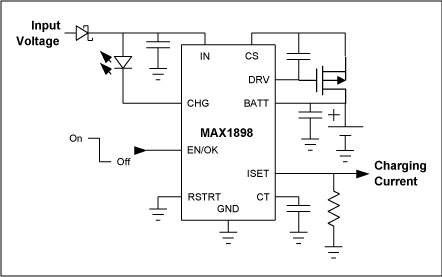
Figure 2. The MAX1898 linear Li+ charger.
Even given the power dissipation problem associated with linear charging, it may still be the best choice for wireless devices. Because there is no switching action and no inductors are required, linear chargers have lower conducted and radiated emissions than other types of chargers. This reduced noise may make the linear charger an appropriate solution for noise-sensitive wireless devices.
The MAX1898 includes: a charging indicator that can directly drive an LED or microcontroller, a battery undervoltage circuit that reduces the charging current for over-discharged batteries, a timer to turn off the charger after charge completion, and an adjustable restart threshold to automatically resume charging if the battery is discharged. The ISET pin both sets the charging current and indicates its level while the charger is regulating voltage. The voltage at the ISET pin can be monitored by an ADC or comparator to determine when the battery charging current has dropped to a low enough level; either this level or the on-board timer can be used to terminate charging. The controller also includes an output pin that indicates charging status (/CHG\) and a combination input and output pin (EN/OK) that both indicates the presence of the input voltage and enables the charger.
Pulse Chargers
The third type of Li+ charger, the pulse charger, shares some of the advantages of both switch-mode and linear chargers. Like a switch-mode charger, a pulse charger operates efficiently. When the voltage of the battery it is charging is low, its pass transistor remains on and conducts the input source current directly to the battery. As the battery voltage reaches the battery regulation voltage, the charger pulses the input current to achieve the desired charging current, thus regulating the battery voltage at the desired voltage limit. Because the transistor does not operate in its linear region during this portion of the charge cycle, but acts like a switch and the dissipated power is much lower than that of a linear charger. Since a pulse charger doesn't require an output LC filter, it's smaller than a switch-mode charger.Figure 3 shows the MAX1736 Li+ pulse charger. It rivals a linear charger in terms of simplicity and small number of external components. With its lower power dissipation, the tradeoff between charge time and power dissipation needn't be considered as with a linear charger.
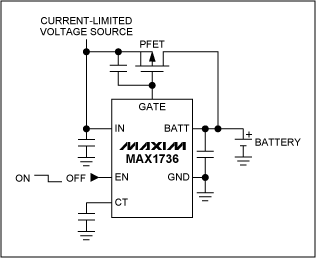
Figure 3. The pulse-mode Li+ charger.
The pulse charger isn't without its special requirements, however. For one, the input voltage source that feeds the charger must be current limited. The current limit needs to be reasonably accurate; wall cubes with this level of accuracy are not as universally available as those that without an accurate current limit. They are also more expensive. In some cases, however, AC-adapter current limiting is specified accurately enough to ensure that a fault in the device it powers doesn't create a safety hazard. If the accurate input-current limit is required for this or other reasons, then no additional cost is incurred when utilizing it for charging.
The MAX1736 automatically charges the battery at a low 6mA current when the battery voltage is below 2.5V to prevent damaging it in its over-discharged state. The controller, however, does not automatically terminate charging. In most cases it terminates charging after the charging current drops below some threshold, typically 10% of the charging current limit. To set up this mode of charge termination, the GATE pin of the MAX1736 is used to directly drive an input of a microcontroller. By measuring the duty cycle of the GATE pin voltage, the microprocessor determines the average current. For the 10% case, once the duty cycle at the GATE pin drops below 10%, the microcontroller terminates the charging. The microcontroller can also disable the MAX1736 by driving the EN pin. When the input source is gone or EN pin is low, the drain on the battery is reduced to 2μA to prevent the charger from discharging the battery after charging is completed.
Conclusion
Switch-mode chargers dissipate little power over wide variations of input and charging voltage and current, but suffer from greater cost and complexity than other types. Linear chargers are smaller and less complex than switch-mode devices, but in most cases they dissipate more power. Pulse chargers dissipate significantly less power and consume little board area, but require the more-expensive AC adapters that limit the current drawn from them. The best choice emerges only after weighing which of these various factors are of most importance for a particular design.A similar version of this article appeared in the November 2001 issue of Wireless Design and Development magazine.
 電子發(fā)燒友App
電子發(fā)燒友App










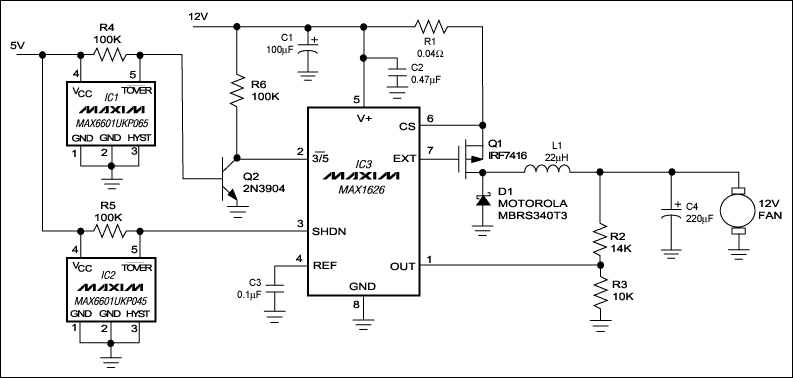
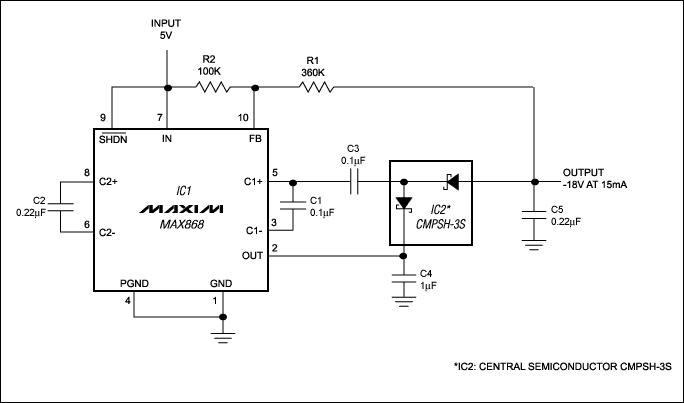
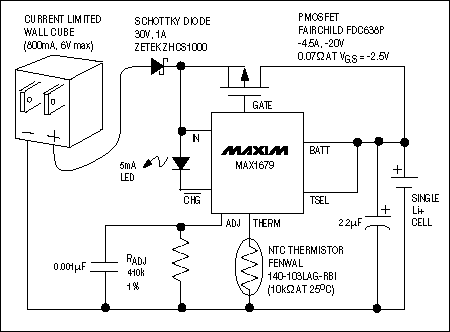
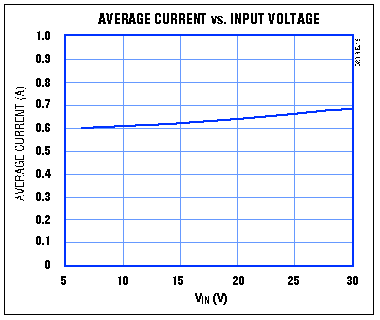
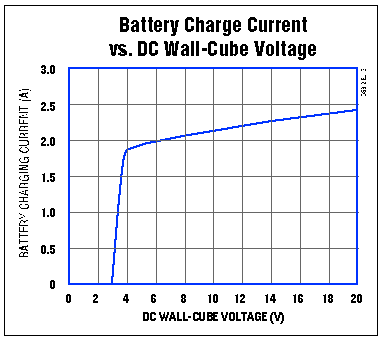
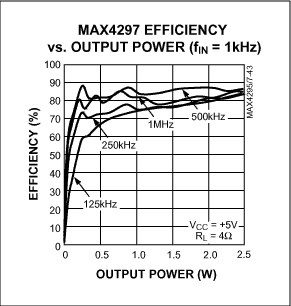
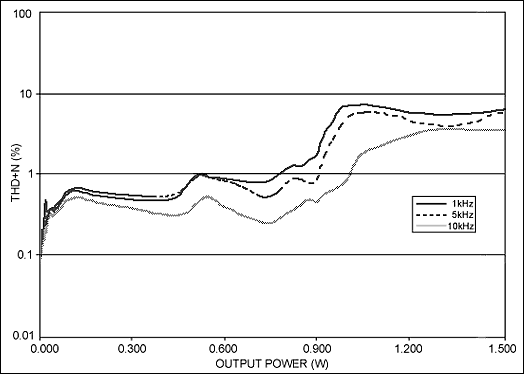
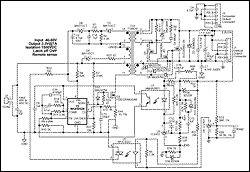
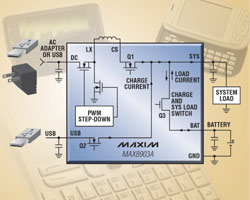
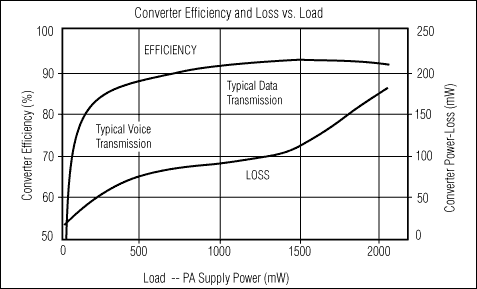
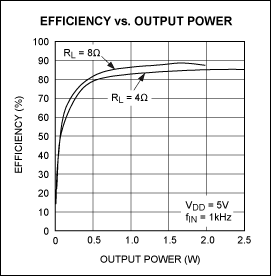











評(píng)論